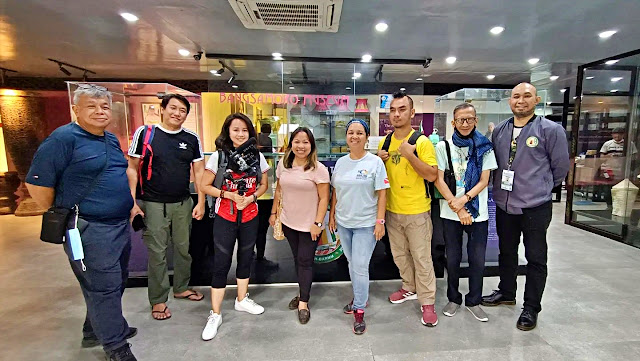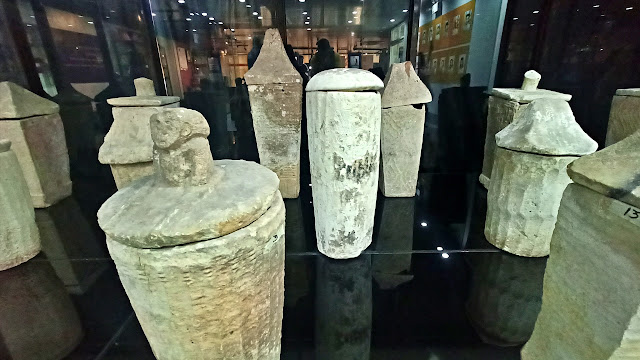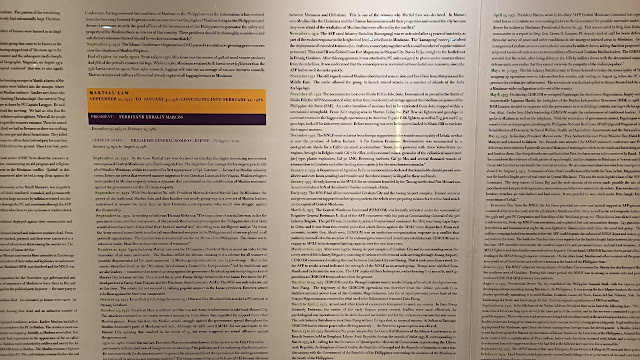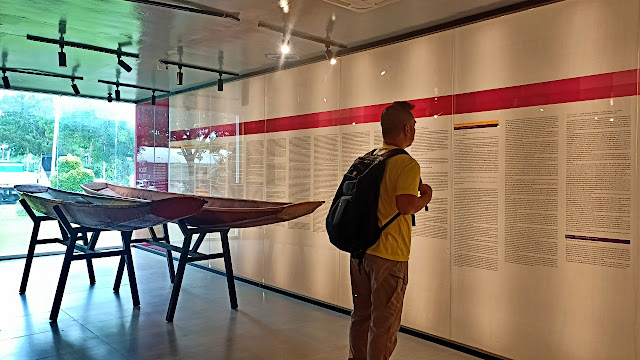Visiting a museum is another way of learning more about a place, which is why I look forward to stepping into one every time I travel to a new destination. Having been into the biggest museums in the country, such as the National Gallery, the National Museum of Natural History, and other NHCP museums, I taper my expectations when I stumble upon smaller ones.
 |
| These limestone burial jars wow'ed me immediately |
Upon our visit to the Bangsamoro Museum in Cotabato City, I found myself with modest expectations regarding what lay ahead. To my astonishment, just moments after stepping inside, I was welcomed by a rich array of artifacts that spoke volumes of the BARMM region's remarkable history.
 |
| With fellow travel writers and the museum guide. |
The first section of the Bangsamoro Museum where the guide ushered us was the gallery, which displayed a collection of burial jars. I was immediately intrigued by the sight of these jars, which date back centuries, because they seemed eerily similar to burial jars I had seen in the Cairo Museum a few years prior.
Burial Jars made of Limestone
The limestone jars, which number twenty-one in all, are called “secondary burial jars” because the body is typically left to decompose until it is stripped to the bones and put inside it.
 |
| These 2,000-year old burial jars are such astonishing finds |
The jars were discovered on the Kulamana Plateau in South Cotabato and in Palimbang, Sultan Kudarat, by researchers from the University of San Carlos (USC) during the early 1960s. Not long after, experts from other countries quickly arrived to analyze the jars, and eventually estimated the jars to date back to 2,000–2,500 years after administering carbon dating.
 |
| Veteran Historian and Cultural writer Amadis Ma Guerrero looks on |
Examination of the jars and further excavation from the area where they were discovered continued until the early 1970s, when it was halted after former President Ferdinand Marcos ordered the bombing of MNLF camps in the region following the declaration of martial law.
 |
| Resting place of people from a very early Philippine civilization |
The older burial jars came in quadrilateral shapes with cylindrical lids. The bodies of the jars are decorated with different geometric designs, and the lids are adorned with depictions of human features that hint at the gender of the deceased—often phallic for males and mammary for females.
 |
| A Maranao “panolong" or “okir” found from a destroyed home in Marawi's Ground Zero |
“I believe there would have been more of these if it weren’t for treasure hunters who discovered the other burial jars before they were unearthed by scholars”, our guide told us.
 |
| Mobile Museum Boxes housing artifacts of the region's flora and fauna are also on display |
The abundance and age of the jars, which span over two millennia, provide compelling evidence of a vibrant and dynamic culture in the Philippines well before the arrival of the Spaniards in the early 16th century. So, even if you thought that you have delved deep into our nation's past, know that there is still a great deal of narrative to discover.

As well as traditional Mindanaoan musical instruments like the Agong

A Showcase of Bangsamoro’s Culture, History and People
Located inside the Bangsamoro Government Center in Cotabato City, the museum was founded in 2019 on the initiative of Mujiv Hataman, the last ARMM Governor before the BARMM law took effect. Managed by the Bangsamoro Commission for the Preservation of Cultural Heritage (BCPCH – BARMM), the museum maintains the collection of artworks, textual and iconographic documents as well as cultural and historical relics from the Bangsamoro Autonomous Region in Muslim Mindanao (BARMM).
 |
| A Holy Quran discovered in the ruins of Marawi's Ground Zero |
Another feature of the museum that one shouldn’t miss are the thousand-year chronicle of Islam in the Philippines and the modern history timeline composed of a lengthy written narrative plastered on one of the walls — a key section details the horrors committed against the Muslims during the Martial Law years. Along with other interesting exhibits, such as textiles made by the Sinagtala weavers during the Marawi siege and other remainders from its battleground’s Ground Zero, documents about the Peace Process and the Bangsamoro Organic Law, a recording of the Tausug Kissa chant that recreates the prayer chant of the victims of the Bud Dajo massacre of 1906, and a collection belonging to Moro Islamic Liberation Front founder Hashim Salamat, the museum also has a collection of traditional clothing and musical instruments.
 |
| The section of the Modern History Timeline narrating the abuses of Martial Law |
Quoted by the Philippine Daily Inquirer, Marian Pastor Roces, the commissioned curator of the museum, said that the museum's "ambition is o affirm the experience of Muslim Filipinos at besting the odds—to hold a mirror to the Maranao, Maguindanao, Yakan, Tausug, Sama and other Islamicized peoples."
 |
| Trying to read as much Historical accounts |
As we end our tour of the Bangsamoro Museum, my tapered expectations were replaced by a feeling of euphoria akin to someone who discovered something significant. Mine didn’t came in material treasure but through a new set of knowledge and a better understanding of the history of the Bangsamoro people. I couldn’t be happier about the new things I learned that day.
Klook.com





















